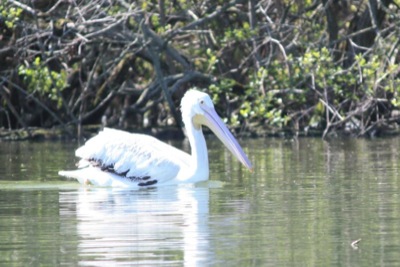Friday, May 29th, 2009
Dirty lake? Wildlife isn't complaining
By Shelley Grieshop

Submitted Photo
An American white pelican is pictured on the south side of Grand Lake near Prairie Creek, where lakeside resident Linie Zumberge spotted the large bird recently. Despite the recent news that shows toxic algae has become a lake health hazard, a variety of new wildlife species continue to make the waterway their home.
Local sightings of non-native Ohio birds and efforts to stock a new species of fish in Grand Lake appear to counter recent warnings describing the state's largest inland lake as an environmental health hazard.
"It's interesting to learn about these new species at the lake," said Ray Petering of the Ohio Department of Natural Resources (ODNR) Division of Wildlife. "With what we're finding out about water quality there, it makes you wonder how anything's staying alive."
A pair of American white pelicans - a fairly rare sighting locally - visited the West Bank State Park area for several weeks in January. A pair, possibly the same ones, were spotted this month in the Club Island area of Montezuma.
Local resident Linie Zumberge first saw the pelicans while canoeing last week with a friend, Vern Raymond, near Prairie Creek.
"We were paddling the canoe through a shallow area with underbrush when we startled the big bird," he said.
It was the first time Zumberge, a lake-area resident since 1977, ever saw a pelican in the area.
"We have witnessed swans, watched the resurgence of blue heron, turtles laying eggs, deer crossing the lake, foxes on the ice and the introduction of eagles," he said, adding he appreciates the wildlife attracted here.
Local residents also continue to spy great white egrets at several locations around the lake. The wading birds, which are cousins to the more familiar great blue heron, have become regular visitors to the area.
The egrets and pelicans are considered migratory, just passing through. But are they? And if the lake is so polluted by livestock manure, pesticides and failing home sewer systems, wouldn't they sense this and fly elsewhere?
"I don't know. Could it really be that bad? It does make you wonder," Petering replied when asked.
While ODNR teamed up last week with the Ohio Environmental Protection Agency and the Department of Health to warn the public about the lake's health risks due to the toxin created by the water's blue green algae, its own wildlife division on Friday stocked Grand Lake with a new species of saugeye to promote fishing.
Petering agreed the Mercer-Auglaize county area in recent years has become home to many wildlife species that once were considered rare to the region. American bald eagles are now a regular sight with nearly two dozen eaglets hatched in the last nine years from two resident pairs. The adult eagles again this spring hatched an undetermined number of eaglets on the south side of the lake.
Osprey also are increasing in numbers in Ohio and the Grand Lake area. Also called fish hawks, they are large black and white raptors with yellow eyes, which enjoy sitting atop high fixtures to spot their prey.
Local wildlife officials last year erected an osprey nesting platform behind the Auglaize & Mercer Counties Convention and Visitors Bureau on Edgewater Drive to encourage the birds to nest.
Petering said "It's not out of the realm of possibility" that some of these rare birds will become year-round lake residents.
"Some years are milder with the variable weather we have here in Ohio. If they have secure places to hang out, open water and food, there's always the possibility they'll stick around," he added.
Great blue herons, which have established rookeries in several locations in the area, along with many Canada geese and some mallard ducks, stick out the winter months along the lakeshore, he said.
It's a fact the various pollutants and the shallowness of the lake provide the "perfect recipe" for the toxic blue green algae that continues to flourish in Grand Lake, he said. But he hopes all the negative attention now focused on the problem will result in answers, he said.
"The lake is an incredible resource to your communities and it supports a lot of wildlife species. It is one of the most precious resources in Ohio, too precious not to look for solutions," he added.

